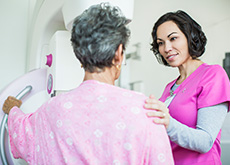Sarah Ochs
Riverview Health Bone & Breast Center supervisor
While getting an annual mammogram is certainly not the most pleasant experience for a woman, it’s a necessary one. One woman in eight will be diagnosed with breast cancer during her lifetime, and 80 percent of those diagnosed have no family history. While there is no definitive res earch on the cause of breast cancer, doctors agree that finding it in its earliest stages will always result in the best results for the patient.
earch on the cause of breast cancer, doctors agree that finding it in its earliest stages will always result in the best results for the patient.
Fortunately, we know how to best monitor the breasts so that if cancer occurs, it is caught in its earliest stage. The American College of Radiology recommends that all women start having annual mammograms at age 40. However, not all mammograms are the same. Recent studies have shown that a three-dimensional (3D) mammogram finds more cancers than the traditional two-dimensional mammogram and also reduces the number of false positives.
The 3D mammogram allows the radiologist to identify cancers and distortion in a more accurate way than ever before, because it acquires more images and information during the mammogram in a shorter amount of time. The 3D mammography detects 41% more invasive breast cancer than a traditional mammogram.
The 3D mammography is especially beneficial for women with dense breast tissue, because it shows more detail than was ever available with the traditional two-dimensional mammogram. This can eliminate many of the false positive results that some women may routinely experience.
Women with dense breasts often get called back for a follow-up mammogram or ultrasound when there was an area that the radiologist couldn’t see well enough. The 3D mammography can eliminate many of those call-backs as well as the unnecessary worry for those women.
An annual mammogram is important for all women’s health. For more information about the Riverview Health Bone & Breast Center, call 317.776.7133.
